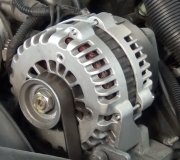I'm not familiar with what type of test you're doing but it sounds like you're looking for a drain after the engine is stopped. That's totally the wrong direction to be going.
First of all, even if there's a drain, the generator should still be charging the battery when the engine is running. Besides any drain, a good 20 to 30 amps is needed to run all the other stuff like computers and electric fuel pump. If one of the six diodes inside the generator fails, all it will be able to supply is one third of its rated capacity, which is around 30 amps. That won't leave anything left over to recharge the battery. Drains that occur with the engine off won't kill the battery while driving so you need to be looking into a generator problem.
Second, there is going to be a drain on the battery with the engine off due to all the many memory circuits in the computers and radio. The industry standard is 35 milliamps, (.035 amps) maximum. At that rate many manufacturers say a good battery will crank the engine after sitting for three weeks. A few manufacturers allow up to 50 milliamps. Cadillac might be one of them, but that will still let the engine start after sitting at least two weeks.
Third, by the mid '90s there were some computers that have to time out for up to 20 minutes before they go to "sleep mode". There can be up to a three amp draw during that 20 minutes so you have to wait until then to do a drain test. To complicate matters much more, anything you do to break the circuit wakes those computers up and then you have to wait another 20 minutes to do any testing. That includes removing a battery cable. You need a digital volt / ohm / amp meter to accurately measure the drain, and even switching ranges on the meter will wake those computers up. A light bulb or a bulb in a tester won't allow enough current to get through to let those computers do their self-test procedures and go to sleep so there will continually be a large drain.
The setup for these cars involves using a meter and a small jumper wire. I'm not familiar with a drain tester that uses a light bulb, but up to the mid '80s it was common to use a small 12 volt bulb in series with a battery cable to indicate a drain. Those worked on cars with no computers because anything that could draw enough to kill the battery would draw a lot of current and kill it in a few hours. Typically that meant glove box and trunk lights that weren't turning off which would make a test bulb glow. With computers, the drain can be way too small to make the bulb glow, so that method doesn't work on newer cars.
I'm in the middle of an on-going conversation with someone else, also with a Cadillac, about this same issue, and in response I'm working on a new page on my web site about testing for battery drain. The procedure isn't that complicated but it's too confusing to keep trying to describe without pictures and drawings. I should have it done in a couple of days, then I'll post the link.
The tests you need to start with are for the generator. You must find 13.75 to 14.75 volts at the battery with the engine running. If you do, the next step is a load test. Your generator should be capable of producing at least 90 amps. Most professional testers also measure "ripple". That's not a number; it's displayed on a bar graph from low to high. If it's high, that's almost always accompanied by low output and is caused by a defective diode.
Without going into lots of detail right now, if the generator is defective, replace the battery also to prevent repeat generator failures, unless your battery is less than about two years old.
If the generator is not the problem, everything electrical on the car should work properly with the engine not running. Since you do have a new battery already, measure the voltage with the engine off. It should be 12.6 volts if it's fully charged. If you find it's closer to 12.0 volts, it's okay but discharged, (pointing to a generator problem). If necessary, recharge the battery with a battery charger, then see if everything works on the car. If there's still a problem, we need to be looking at the electrical supply system. I mentioned previously the two smaller battery wires attached to the car body and under-hood fuse box. Wiggling wire harnesses often shows up a problem. Also consider loose or corroded fuses in the under-hood fuse box, and wire connections where they go through the firewall. With the head lights turned on to give you a visual indication, and to put a load on the electrical system, look closely at and wiggle the red battery wire bolted to the fuse box. Even if it's tight, there can be an arced circle under it causing a poor or intermittent connection. We can do more voltage tests to identify that possibility or you can just unbolt it to sand it clean.
Sunday, April 22nd, 2012 AT 5:06 AM



